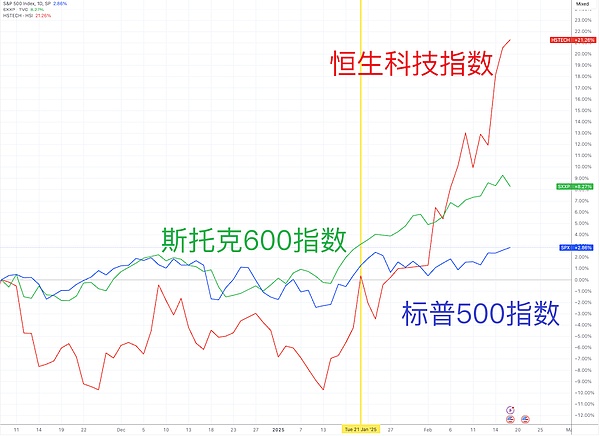
Author: Shi Zhengcheng
As US President Donald Trump completes his first month of his new term , a series of assets show that investors' enthusiasm for the so-called "Trump deal" is waning.
From the S&P 500 index, which symbolizes the US stock market, to the US dollar, US bonds, and even the fanatical momentum of cryptocurrencies, they are now in a state of hesitation. Just over three months ago, investors were betting on Trump's relaxation of regulation, tax cuts and US isolationism, U.S. stocks, the US dollar and Bitcoin soared, and U.S. bond yields also rose against the backdrop of rekindled inflation.
Facts have proved that in the face of the imagined Trump's gradual implementation, investors have also returned to reality from their fantasy.
(The S&P 500 index was crushed by European and stock indexes, source: TradingView)< /p>
In the U.S. stock market, the S&P 500 rose 2.5% in the first month of Trump's take office, while the Nasdaq, which is mainly tech stocks, rose 2.2% . In a horizontal comparison, the European stock market, which has been overwhelmed by US stocks for many years, performed significantly better, with the Stoke 600 index rising by more than 5%, setting a new record high. Of course, these two are incomparable compared to the assets that are being "revaluated".
The change that is more worthy of attention is the reversal of small-cap stocks in the US. The day after the US election last year, the Russell 2000, which represents US small caps, rose 5.8%, the largest single-day gain in the past three years. To this day, this small-cap index is only 1% higher than its closing price on November 5.
(Russell 2000 Index Daily Chart, Source: TradingView)
< p style="text-align: left;">From the investment logic, small and medium-sized enterprises' business is more focused on, which should have been the beneficiaries of "America First". However, after Trump took office, he randomly waved the tariff stick, which not only caused concerns about rising inflation, but also cast a shadow on the future profit prospects of American small and medium-sized enterprises, which are not strong in pricing power.(Source: MISH TALK)
At the same time, financial stocks and new energy industries fluctuate roughly according to market expectations. Although Trump It seems that strict antitrust strategies will continue to be adhered to, but there is no change in relaxing financial regulation and supporting fossil fuels.
Another "Trump deal" is eliminated The case of fading is the US dollar. The dollar index rose roughly 6% from Election Day to Trump's inauguration, but has fallen by 2% in the past month.
(Source: TradingView)
Part of the reason why the dollar lost its momentum is that traders overestimated the impact of Trump's tariffs on the dollar. Having said that, the U.S. president still brought a lot of volatility to the market . For example, after the announcement of tariffs on Canadian and Mexican peso, the Canadian dollar and Mexican peso were hit at one point, but with the delay of tariffs, the market trend quickly reversed.
With the US dollar Similarly, there are US bonds. After Trump won the election, many market voices said that "US inflation is coming", and the yield on the 10-year US bonds quickly rose by 60 basis points. But in the past one In the month, Becente's Ministry of Finance made it clear that it would maintain the stable scale of debt auctions in the short term, and the "Efficiency Department"'s move to cut spending greatly alleviate market concerns about the federal deficit issue.
(Source: TradingView)
Method Gunette Dingra, head of U.S. interest rate strategy at Pakistan Bank, explained that around the time of the U.S. election, there was a Trump deal driven by "bond police" in the market. But what happened after the inauguration was the opposite, and the yield curve has been
The last one closely related to "Trump Transaction" is Bitcoin, but this speculative asset has not said to be "reversal". Since last year's US election, Bitcoin has soared from more than $70,000 Rising to a record high of $100,000. However, the crypto industry has been waiting for substantial implementation in the past month, so it has been fluctuating around $100,000.











